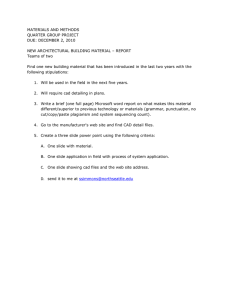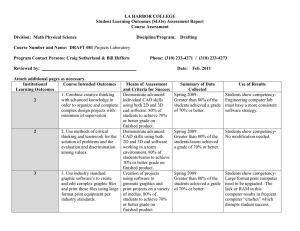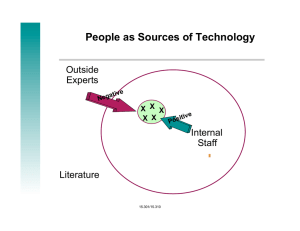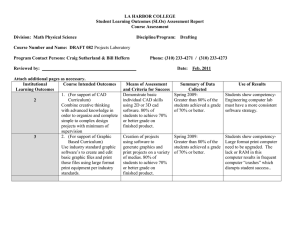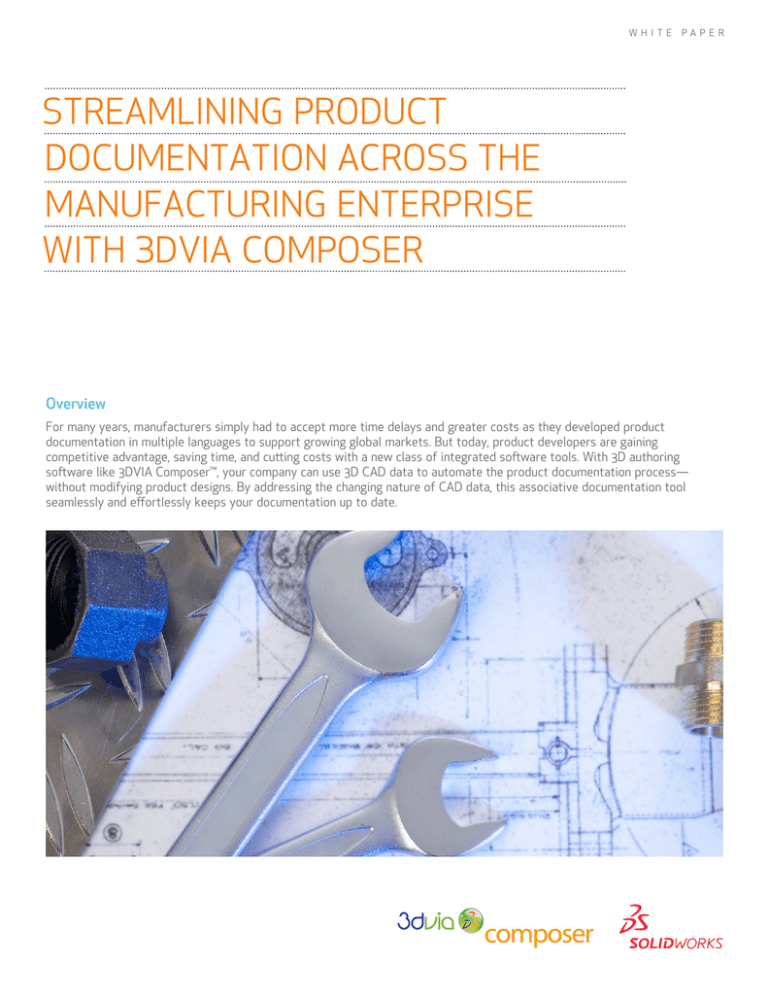
W H I T E
PA P E R
STREAMLINING PRODUCT
DOCUMENTATION ACROSS THE
MANUFACTURING ENTERPRISE
WITH 3DVIA COMPOSER
Overview
For many years, manufacturers simply had to accept more time delays and greater costs as they developed product
documentation in multiple languages to support growing global markets. But today, product developers are gaining
competitive advantage, saving time, and cutting costs with a new class of integrated software tools. With 3D authoring
software like 3DVIA Composer™, your company can use 3D CAD data to automate the product documentation process—
without modifying product designs. By addressing the changing nature of CAD data, this associative documentation tool
seamlessly and effortlessly keeps your documentation up to date.
Introduction
Over the past decade, dramatic advances in 3D computer-aided design (CAD)
technology have given designers and engineers powerful tools for designing,
engineering, and manufacturing new products. Powerful CAD tools are helping
engineers not only create and visualize innovative designs, but also shorten
design cycles, accelerate time-to-market, reduce development costs, and improve
product quality. For many manufacturing organizations, however, most benefits
associated with implementing CAD technologies have involved processes that occur
before production. As a result, product design and engineering primarily reap the
advantages of CAD data. While 3D CAD has made designers and engineers more
productive and efficient, the innate value in the CAD models they create often ends
with the delivery of 2D drawings or printed materials to manufacturing.
As many engineers can attest, requests for CAD-related information, images,
and content—in a variety of layouts and formats to fulfill functions other than
design and engineering—are numerous and often arise after a design’s release for
production. All products need documentation, and most require the production of
assembly, service, and training manuals. The utility of 3D data extends even to the
creation of marketing materials and web-based content. For any company that
designs and manufactures products, CAD models and their associated intellectual
property are the fundamental source of product information, driving efficiency
through all the subsequent communication functions that traditionally took place
after product design.
As manufacturers strive to find ways to become
leaner, more efficient, and more competitive in
global markets, generating CAD data to satisfy
all the product documentation requirements
of the manufacturing enterprise may hold the
greatest potential for improving productivity.
As manufacturers strive to find ways to become leaner, more efficient, and more
competitive in global markets, generating CAD data to satisfy all the product
documentation requirements of the manufacturing enterprise may hold the greatest
potential for improving productivity. Instead of cutting into an engineer’s time
to do high-resolution screen captures, create special exploded views, or write
instructions for manufacturing, service, and marketing purposes, you can use an
integrated content authoring tool and other resources to create product graphics
and illustrations directly and simultaneously from 3D CAD models.
Product documentation is often a separate step that takes place after product design in many
product development processes, creating delays and the need for additional rework. Shortening
this step by using a 3D authoring tool to develop documentation content concurrently can
accelerate time-to-market and increase competitiveness.
Historically, product design, documentation, manufacturing, and marketing
processes have occurred sequentially, with one function closely following the
other. Technical illustrations, exploded part diagrams, assembly instructions, and
high-resolution graphics typically follow the release of the design for production.
Streamlining Product Documentation across the Manufacturing Enterprise with 3DVIA Composer
2
In addition to extending the time required to complete the product development
cycle, the sequential approach is neither flexible nor automated. Whenever a design
modification that requires a change to the CAD model arises late in the process,
manufacturers must manually address all the attendant functions through a period
of rework, creating opportunities for more errors, further delays, and cost overruns.
Now you can address all your product documentation needs—including materials
for manufacturing, service, user manuals, and marketing—by using a new class
of documentation authoring applications to repurpose 3D CAD data. Known as
3D authoring software, these tools extend the utility of CAD data and automate
the development of product documentation and related materials. While many
organizations already leverage 3D CAD content in some fashion, a 3D authoring
tool allows you to avoid the rework associated with updating CAD models to
incorporate engineering changes into downstream documentation. Software that
updates content directly from the CAD model can distribute design modifications
throughout all related deliverables.
By implementing a documentation authoring
solution, your company can realize greater
accuracy, increased efficiency, and a more
significant return on investment (ROI) within the
first year.
As the design changes, 3D authoring software enables technical illustrators to
create and update exploded views. Manufacturing specialists can develop and
update graphics in assembly instructions, and customer service personnel can do
the same in service documentation. This powerful software also allows marketing
professionals to render and update catalog images. If the CAD model changes, you
can automatically update all of the related content. This concurrent approach serves
to compress development time, squeeze costs out of the process, and alleviate
demands on engineering, all while maintaining the integrity of the original CAD data.
By implementing a documentation authoring solution, your company can realize
greater accuracy, increased efficiency, and a more significant return on investment
(ROI) within the first year. Time and cost savings related to resource reductions
in publication creation, assembly operations, engineering change order (ECO)
processes, and warranty claims will eclipse the cost of the solution during the first
year and continue to grow with each passing year. By integrating and automating the
creation of product documentation, you can decrease labor costs associated with
document publication, localization of materials, and training. At an organizational
level, the ROI associated with the new processes becomes most evident through
shorter time-to-market, improved operational efficiencies, and better quality
documentation.
Using a 3D authoring tool like 3DVIA Composer software, manufacturers can generate CAD data to
meet documentation, assembly, manufacturing, training, service, and marketing content needs,
automatically and simultaneously. 3DVIA Composer enables you to produce documentation as
much as 30 percent faster than with conventional methods, and realize significant ROI by reducing
documentation, training, and localization costs.
Streamlining Product Documentation across the Manufacturing Enterprise with 3DVIA Composer
3
Automating manufacturing and assembly instructions
By implementing an integrated documentation solution, you also can enhance
an important internal function—the efficient creation of more effective 3D
manufacturing and assembly work instructions. Traditionally, manufacturers have
relied on the use of 2D engineering drawings—with exploded views, annotations,
callouts, and balloons—to instruct manufacturing personnel and assemblers in
producing components, subassemblies, and assemblies. Some of these work
instruction documents are quite lengthy and wordy, heavily relying on the use of
text to convey important production details to an audience on the shop floor who
may lack both English-language and reading skills.
In a global economy, unanticipated language
and literacy barriers between design and
manufacturing personnel can get in the way of
achieving right-first-time production.
In a global economy, unanticipated language and literacy barriers between design
and manufacturing personnel can get in the way of achieving right-first-time
production. Often, time is wasted in finding and verifying components, or in trying to
understand manufacturing and assembly work instructions. Manufacturing personnel
on the shop floor—who may speak another language or reside in another country—
cannot simply place a call to engineers to clarify a design. Even if production resides
in the same building, the literacy levels of personnel on the assembly floor can lead
to questions, difficulties, and delays. That’s why nontextual, visual 3D content is
becoming increasingly important for communicating vital manufacturing information.
A simple, animated 3D work instruction can convey manufacturing and assembly instructions more
clearly, effectively, and universally than text-based 2D drawings—and can help manufacturers
reduce production errors and lower manufacturing costs.
An integrated 3D authoring application provides the opportunity to minimize the
use of text in work instructions and reduce the potential for misunderstandings.
The visualization of products that forms the basis of 3D work instructions
represents a universal language that can help convey manufacturing and assembly
tasks in a straightforward manner with less chance for misinterpretation. The simple
animation of a CAD model can explain the finer details of assembly operations more
clearly and effectively, and thus replace an entire stack of documents. By providing
universally understood 3D manufacturing and assembly work instructions, your
company can minimize iterative cycles and disagreements between engineering
and production. Addressing the root cause of errors, delays, and rework can drive
additional costs out of the production process.
By providing universally understood 3D
manufacturing and assembly work instructions,
your company can minimize iterative cycles
and disagreements between engineering and
production.
Streamlining Product Documentation across the Manufacturing Enterprise with 3DVIA Composer
4
Creating better user manuals and product documentation
While product documentation can fulfill a range of uses, its core purpose is
twofold: to provide customers with the information they need to use and enjoy a
manufacturer’s product and to develop customer loyalty for that product. Therefore,
the production of user manuals, part lists, and product schematics is an important
function for building customer satisfaction and loyalty—one that requires the
contributions of illustrators, writers, and publishing specialists. Whether product
documentation personnel are engineers or have a limited engineering background,
they can substantially increase their chances of success by creating graphical
content directly from CAD models.
With a 3D authoring tool like 3DVIA Composer, product documentation specialists
can avoid using a CAD system or asking an engineer to produce product information
such as exploded views, vector line art images, or annotations.
Instead of re-creating visuals from the finished product, they can create 2D and
3D visuals to meet any documentation requirements. Whether the need is vector
line art of an exploded view for technical illustrations or a detailed view of a highresolution raster image for a user manual, documentation professionals can save
time and improve the visual’s quality by accessing and reusing native CAD data. The
flexibility of integrated documentation software eliminates the need to go back and
forth with engineering to obtain the precise views, angles, and colors required for
documentation; you can create this content from the CAD model, but cannot alter or
change the design.
The interactive nature of 3D provides an
effective means for showing your customers
how to use a product and for illustrating how
that product works.
Product documentation professionals can save time and improve the quality of documentation
visuals by utilizing a 3D authoring tool like 3DVIA Composer to create documentation graphics
directly from native CAD data.
With the explosive growth of digital and online documentation systems, 3D
authoring software also enables documentation publishers to use animations within
user manuals and product help systems. The interactive nature of 3D provides
an effective means for showing your customers how to use a product and for
illustrating how that product works. With more and more user manuals published
either online or on CD-ROM, animation capabilities are fast becoming an important
part of the product documentation toolkit. Integrated documentation software
provides the capabilities for creating interactive content from the actual product
CAD file.
Streamlining Product Documentation across the Manufacturing Enterprise with 3DVIA Composer
5
Delivering accurate field service, maintenance, and repair information
In a global economy where customers reside in different countries, the ability to
provide accurate and universally comprehensible field service, maintenance, and
repair documentation is critical. No matter who executes the service, maintenance,
or repairs—the customer, an authorized service representative, or an employee—
the ability to perform service and maintenance procedures efficiently, with as little
down time as possible, is vital for retaining customers. It requires access to selfexplanatory, clear, and concise product documentation.
Providing this type of product documentation has presented greater challenges,
added demands on engineering resources that do not carry primary responsibility
for its development, and increased operational costs. For example, documenting
the intricate details necessary for showing how to dismantle a machine, perform a
maintenance service or repair, and reassemble it might require a series of step-bystep graphics from engineering. Service technicians frequently call in to engineering
departments to get this type of information for use in the field. Complicating
this challenge even further is the fact that the field-service technician may speak
another language, requiring translations of service or repair documentation
materials, which adds further costs and also delays product shipment in many
industries.
Using 3D authoring software, manufacturers
can create animated, graphically rich service
instructions directly from CAD models.
With 3DVIA Composer, manufacturers can replace text-based field-service instructions with
graphics and video animations, thereby improving service operations, minimizing the need for
language translations, reducing training needs, and decreasing operational costs.
Using 3D authoring software, manufacturers can create animated, graphically rich
service instructions directly from CAD models. Instead of having field-service
technicians call in to engineering, manufacturers can show service technicians
how to complete maintenance, service, and repairs in the universal language of
visualization. By replacing unwieldy service books and text with step-by-step
graphics and images, you can share interactive, animated service instructions with
global partners over CD-ROM or via the web, ensuring the effective distribution
of product knowledge to customers and field-service professionals. In addition to
improving field-service instructions and reducing demands on engineering resources,
using 3D authoring software can minimize the need for language translations,
decrease the number of service calls to engineering, and lower operational costs.
Streamlining Product Documentation across the Manufacturing Enterprise with 3DVIA Composer
6
Publishing effective training materials
The ongoing development and publication of product training materials—for
customers, new employees, and global partners—is another area where the
repurposing of CAD design data can pay big dividends for today’s manufacturers.
Because the native CAD files serve as the single source for all product content,
using a 3D authoring tool to customize training materials for specific groups is
far easier and more efficient than crafting these materials independently. This
capability is especially useful—you can create effective training materials without
using the costly textual translation services once required for communicating with
overseas audiences.
Using 3DVIA Composer, manufacturers can manage the development of online product training
materials—for customers, employees, and global partners—efficiently and cost-effectively through
the reuse and generation of CAD design data.
With integrated documentation software that can embed 3D content, markups, and
animations in any ActiveX-compatible business application, manufacturers have the
power to create, manage, and deploy product training documentation on a global
scale, at much lower cost. This capability allows you to embed product training
content in common communication applications, such as Microsoft® Word, Excel, and
PowerPoint®; as a standalone executable for viewing with free player software; or in
HTML format to distribute over the web.
With this flexibility, manufacturers can maximize the use of graphics, animations,
and visual content—while minimizing the amount of text, language translation
requirements, and related costs. In addition, the widespread compatibility of
3D content created with an integrated documentation application helps global
manufacturers to streamline the localization process for product training
documentation. While helping you to drive down costs and improve profit margins,
3DVIA Composer simultaneously enhances the quality, reach, and customization
of your training materials. Support for HTML content can expand your company’s
product training reach to virtually any computer with Internet access.
Streamlining Product Documentation across the Manufacturing Enterprise with 3DVIA Composer
7
Creating vibrant, exciting marketing content and web-based catalogs
Because CAD data enables you to create imagery for print and online marketing
purposes with a 3D authoring tool, it is an incredibly valuable asset. Many
manufacturers spend millions of dollars annually on professional product
photography to present and market their products when a more cost-effective,
high-resolution, CAD-derived image could satisfy the same need. Some media, such
as television and magazines, always will require live-action video and photography.
However, the burgeoning need for digital content and the explosive growth in online,
web-based catalogs both demand visual content that manufacturers can best supply
by repurposing product design data.
Many manufacturers spend millions of dollars
annually on professional product photography to
present and market their products when a more
cost-effective, high-resolution, CAD-derived
image could satisfy the same need.
Even if a manufacturer already derives catalog visuals from CAD files, the process
requires the input of both an engineer and a marketing professional to separate
engineering data from marketing needs. With an integrated documentation system,
marketing professionals can render, modify, and change images to meet specific
printing or marketing needs, such as controlling resolution—pixels and dots-perinch—which is not easy to do with CAD screen captures. Because the CAD model
can be used to update views and animations that match the final product, marketing
professionals no longer need to wait for engineering to finish the product to create
content.
Creating these types of visuals in the past
required significant skill and resources. With
an integrated 3D authoring tool, however, just
about anyone can transform a CAD model into a
dazzling interactive animation.
High-resolution images and animations derived from CAD models using 3DVIA Composer are better
suited—and more cost-effective—for supporting marketing vehicles online and via digital media
than traditional professional photography.
With CAD-derived imagery and animations, manufacturers can make their online
and digital media marketing vehicles more exciting, dynamic, and interactive, while
saving money at the same time. Web-based catalogs, pre-sales demonstrations,
trade show displays, and online brochures are much more vibrant and effective when
they utilize interactive animations instead of static images. Creating these types
of visuals in the past required significant skill and resources. With an integrated
3D authoring tool, however, just about anyone can transform a CAD model into a
dazzling interactive animation.
Furthermore, manufacturers can begin marketing the product upon its release for
production rather than waiting on initial production runs or photography to begin
creating market demand. By repurposing CAD models as marketing visuals and
animations with content creation software, you can reduce photography costs,
increase visual flexibility, and get out in front of product introductions.
Streamlining Product Documentation across the Manufacturing Enterprise with 3DVIA Composer
8
Conclusion
As manufacturing organizations strive to identify ways to save time, cut costs, and
improve their competitiveness in global markets, mining the value contained in their
product design and 3D CAD digital assets holds great potential for substantially
improving productivity. By automating downstream product information publishing
functions—ranging from assembly, manufacturing, and field-service instructions
to product documentation, training, and marketing materials—your company can
realize shorter times-to-market, improved operational efficiencies, and better
quality documentation.
Manufacturers that use an integrated documentation authoring package not only
enjoy greater accuracy, increased productivity, and more cost savings, but also
realize significant ROI within the first year. Reductions in the costs and resources
associated with document publication, localization of materials, assembly, and
training will more than pay for the solution in just a few months—and will generate
savings in time and costs for years to come. Instead of performing product
documentation functions independently after a design’s release for production,
product development organizations can use an integrated 3D authoring tool, like
3DVIA Composer, to meet all documentation needs directly and simultaneously
from the 3D CAD model. In addition to improving efficiency, saving time, and cutting
costs, an integrated documentation system enables documentation to change as the
CAD model changes, keeping associated product content up to date.
By automating the creation of product documentation and related content—and
linking it directly to 3D CAD models—manufacturers can improve profit margins,
achieve faster times-to-market, and increase sales related to better customer
education. A 3D authoring tool empowers you to produce documentation faster and
at lower cost, while reducing levels of rework and lowering production overhead.
With more effective training and service, your company not only will enhance
customer satisfaction, but also will realize shorter maintenance down times and
greater profit margins.
To see online demonstrations of how you can cut costs and improve
documentation, try out a 3D authoring software package yourself, or discuss
your documentation requirements with your local authorized reseller,
visit www.solidworks.com/3DVIAComposer today.
Dassault Systèmes
SolidWorks Corp.
300 Baker Avenue
Concord, MA 01742 USA
Phone: 1 800 693 9000
Outside the US: +1 978 371 5011
Email: info@solidworks.com
www.solidworks.com
SolidWorks is a registered trademark of Dassault Systèmes SolidWorks Corp. All other company and product names are trademarks
or registered trademarks of their respective owners. ©2010 Dassault Systèmes. All rights reserved. MK3DVWPENG1210

